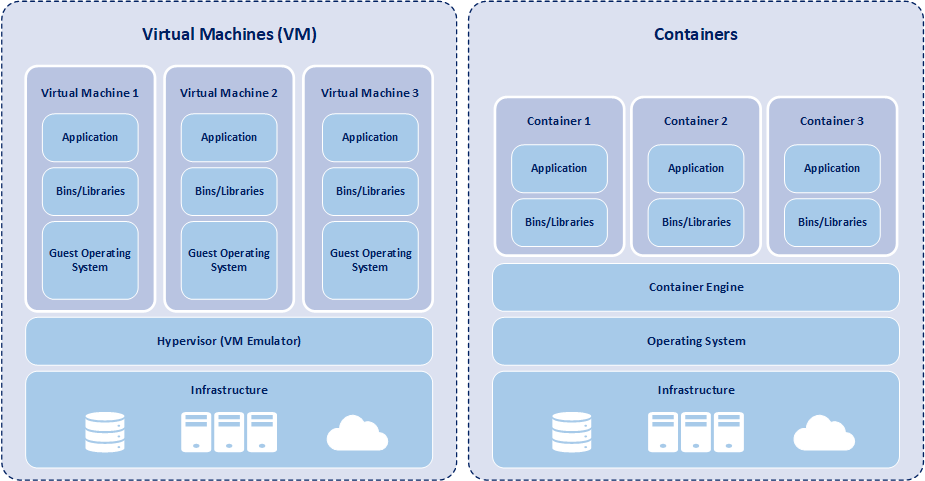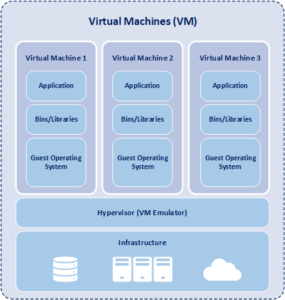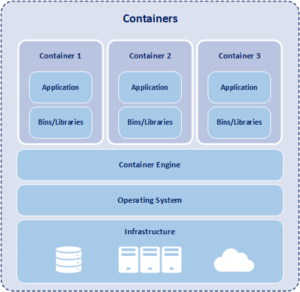Computer Hardware Abstraction: Virtual Machines vs Containers
Emulate Computer Processing with Either Virtual Machines or Containers.
Virtual Machines and Containers are the two most frequently used mechanisms to abstract physical hardware and run applications within independent spaces. Moreover, containers and virtual machines both have similar hardware abstraction benefits. They are both ways of deploying applications while isolating the application from the underlying hardware. But they function differently because containers share an operating system while virtual machines contain a complete and independent operating system.
Virtualization and Virtual Machines
Virtualization emulates computer hardware to enable the hardware elements of a single computer including processors, memory, and storage to be divided into multiple computers, commonly called virtual machines (VMs). Subsequently, a virtual machine is a computer file, typically called an image, that behaves like another computer within a computer. Virtual machines run on an isolated partition of its host computer and contain it their own resources of processing, memory, and operating system (i.e. Windows, Linux, Unix, macOS). A virtual machine provides an environment that is independent from the rest of the host hardware. Whatever is running inside a virtual machine won’t interfere with anything else running on the host hardware.
Virtual machines have been designed to run software on top of physical servers to emulate a particular hardware system. Within each individual virtual machine is a unique guest operating system. Thus, virtual machines with different operating systems can be located and execute on the same physical server (i.e. a Linux VM can be located on the same host computer as a Windows VM). Each virtual machine contains its own operating system as well binaries, libraries, and applications that it services. Virtual machines can be physically many gigabytes in size.
Increased hardware utilization and physical server consolidation are top reasons to utilize virtual machines. Most operating system and application deployments only use a small amount of the physical resources available when deployed to physical hardware. By virtualizing computers and resources, many virtual machines can be co-located on a physical server. Additionally virtual machines can be provisioned much more rapidly than conventional computers and at a much lower cost. Development of applications also has benefited from physical server consolidation because greater utilization on larger, faster servers has freed up unused servers to be repurposed for quality assurance, training, and performance optimization.
Virtual machines are ideal for supporting applications that require an operating system’s full functionality. This can be when multiple applications are deployed on a server, or when there is a need to manage a wide variety of operating systems.
Containerization and Containers
Containerization is defined as a form of operating system virtualization through which applications are packaged in isolated spaces using a common operating system known as containers. Moreover, containers provide a way to virtualize an operating system so that multiple workloads can run on a single operating system instance. A container is a standard unit of software that packages up code and all its dependencies so the application runs quickly and reliably from one computing environment to another. Essentially, a container is a fully packaged and portable computing environment.
Containers are an abstraction at the application layer that packages code and dependencies together. Multiple containers can run on the same machine and share the operating system kernel with other containers, each running as isolated processes. Containers take up less space than virtual machines (container images are typically only a few megabytes in size), can handle more applications, and reduce the need for multiple virtual machines and operating systems. Containers also reduce management overhead as containers share a common operating system. Thus only a single operating system needs to managed.
Containers enable greater server-efficiency, cost-effectiveness, and reduced-overhead over virtual machines. A container doesn’t require its own operating system which corresponds with faster boot times, smaller memory footprints, and generally better performance. Containers also help trim hardware, storage, operating system, and server costs as they reduce the need for using virtual machines.
Containers are a better choice than virtual machines when the priority is to minimize the number of servers being used for multiple applications. Additionally, containers are an excellent choice for tasks with a short lifecycle and for deployment of microservices. With their fast set up time, they are suitable for tasks that may only take a few hours. Virtual machines have a longer lifecycle than containers, and are best used for longer periods of time. In short, containers are lighter weight, smaller, more rapid, and more portable than virtual machines.




